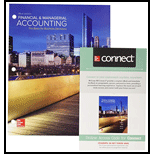
Identify the correct statements.
Answer to Problem 1STQ
Option (a), (b), and (d) are correct answer.
Option (a): The appliance store has a longer operating cycle than the restaurant.
Option (b): The appliance store probably uses a perpetual inventory system, whereas the restaurant probably uses a periodic system.
Option (c): Both businesses probably have subsidiary ledgers for accounts payable.
Explanation of Solution
Option (a): Generally the merchandising company will have the longer operating cycle, as it have the receivables and inventory. But, the restaurants will not have the receivables. Thus, the appliance store has the longer operating cycle. Hence, Option (a) is correct answer.
Option (b): As the appliance store will deals with the huge number of inventory and receivables, it is necessary to keep the up to date records of the inventory or cost of goods sold, thus it is using perpetual inventory system. In restaurants, it is not necessary to keep the up to date information and there is no such inventories and receivables, thus it is using periodic inventory system. Thus, Option (b) is correct answer.
Option (c): It is not mandatory that both the businesses would require subsidiary ledgers for
Option (d): It is probable that both the business will have subsidiary ledger for accounts payable as the company will purchase the goods from the vendors for credit. Thus, option (d) is the correct answer.
As per the above explanation, Option (c) is not correct answer. Hence, Option (a), (b), and (d) are correct answer.
Thus, Option (a), (b), and (d) are correct answer.
Want to see more full solutions like this?
Chapter 6 Solutions
Gen Combo Looseleaf Financial And Managerial Accounting; Connect Access Card
- Cash: 35000, Accounting receivable: 52000arrow_forwardThe actual cost of direct labor per hour is $16.25 and the standard cost of direct labor per hour is $15.00. The direct labor hours allowed per finished unit is 0.60 hours. During the current period, 4,500 units of finished goods were produced using 2,900 direct labor hours. How much is the direct labor rate variance? A. $3,625 favorable B. $3,625 unfavorable C. $4,350 favorable D. $4,350 unfavorablearrow_forwardWhat is the book value of its liability?arrow_forward
- A balance sheet shows cash, $75,000; marketable securities, $110,000; receivables, $90,000; and $225,000 of inventories. Current liabilities are $200,000. The current ratio is 1.375 to 1. a. True b. Falsearrow_forwardWhat is the economic order quantity?arrow_forwardPLEASE help do thi correctlyarrow_forward

 AccountingAccountingISBN:9781337272094Author:WARREN, Carl S., Reeve, James M., Duchac, Jonathan E.Publisher:Cengage Learning,
AccountingAccountingISBN:9781337272094Author:WARREN, Carl S., Reeve, James M., Duchac, Jonathan E.Publisher:Cengage Learning, Accounting Information SystemsAccountingISBN:9781337619202Author:Hall, James A.Publisher:Cengage Learning,
Accounting Information SystemsAccountingISBN:9781337619202Author:Hall, James A.Publisher:Cengage Learning, Horngren's Cost Accounting: A Managerial Emphasis...AccountingISBN:9780134475585Author:Srikant M. Datar, Madhav V. RajanPublisher:PEARSON
Horngren's Cost Accounting: A Managerial Emphasis...AccountingISBN:9780134475585Author:Srikant M. Datar, Madhav V. RajanPublisher:PEARSON Intermediate AccountingAccountingISBN:9781259722660Author:J. David Spiceland, Mark W. Nelson, Wayne M ThomasPublisher:McGraw-Hill Education
Intermediate AccountingAccountingISBN:9781259722660Author:J. David Spiceland, Mark W. Nelson, Wayne M ThomasPublisher:McGraw-Hill Education Financial and Managerial AccountingAccountingISBN:9781259726705Author:John J Wild, Ken W. Shaw, Barbara Chiappetta Fundamental Accounting PrinciplesPublisher:McGraw-Hill Education
Financial and Managerial AccountingAccountingISBN:9781259726705Author:John J Wild, Ken W. Shaw, Barbara Chiappetta Fundamental Accounting PrinciplesPublisher:McGraw-Hill Education





